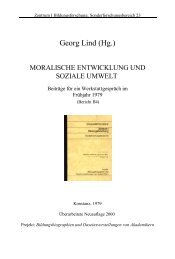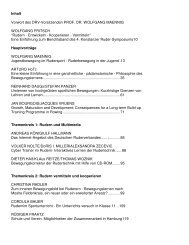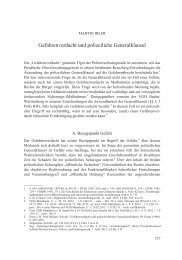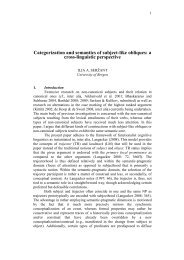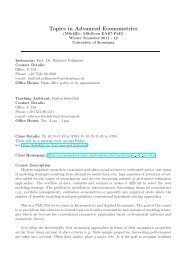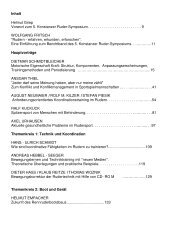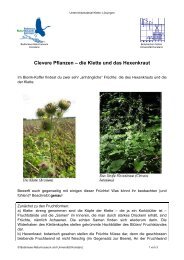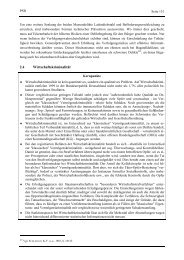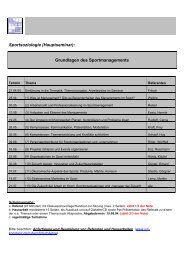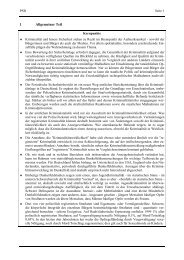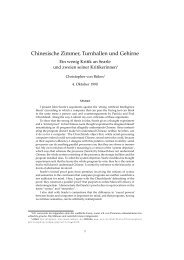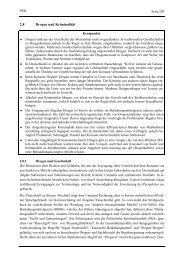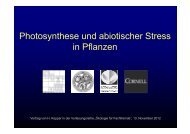Book of Abstracts Book of Abstracts - Universität Konstanz
Book of Abstracts Book of Abstracts - Universität Konstanz
Book of Abstracts Book of Abstracts - Universität Konstanz
You also want an ePaper? Increase the reach of your titles
YUMPU automatically turns print PDFs into web optimized ePapers that Google loves.
Oxidation Effects <strong>of</strong> the Small Chromium and Manganese Cluster<br />
Ions<br />
K. Tono, 1,2 A. Terasaki, 2 T. Ohta, 1 and T. Kondow 2<br />
1 Department <strong>of</strong> Chemistry, University <strong>of</strong> Tokyo, 7-3-1 Hongo, Bunkyo, Tokyo 113-0033, Japan<br />
2 Cluster Research Laboratory, Toyota Technological Institute in East Tokyo Laboratory, Genesis<br />
Research Institute, Inc., 717-86 Futamata, Ichikawa, Chiba 272-0001, Japan<br />
Properties <strong>of</strong> transition-metal clusters are affected by reaction with foreign elements such as<br />
nitrogen and oxygen. For example, it has been predicted that the magnetic property <strong>of</strong> a<br />
chromium dimer is drastically changed by either nitridation or oxidation [1,2]. Motivated by<br />
these theoretical studies, we investigated the electronic structures <strong>of</strong> the chromium- and<br />
manganese-oxide cluster anions through measurements <strong>of</strong> photoelectron spectra and analyses<br />
with the aid <strong>of</strong> the density functional theory (DFT). It was found that the spin magnetic moment<br />
<strong>of</strong> Cr2O – is as large as 9 µB, while that <strong>of</strong> Cr2 – is 1 µB. This result shows that the spin coupling<br />
between the chromium sites becomes ferromagnetic upon oxidation <strong>of</strong> Cr2 – whose chromium<br />
sites are coupled antiferromagnetically [3,4]. The mechanism <strong>of</strong> the ferromagnetic spin coupling<br />
is explained on the basis <strong>of</strong> the geometric and electronic structures obtained by the DFT<br />
calculations. The oxygen atom at the bridge site weakens the strong bond between the<br />
chromium atoms, which is responsible for the antiferromagnetic coupling in Cr2 – . In addition,<br />
significant hybridization between chromium 3d and oxygen 2p orbitals allows electrons in the<br />
same spin state to be transferred from the two chromium atoms to the oxygen atom.<br />
Consequently the local spins on the chromium sites are bound to form a ferromagnetic coupling<br />
in a similar scheme <strong>of</strong> the superexchange interaction encountered in solids. An oxidation effect<br />
<strong>of</strong> a similar kind was found for Mn2O – , in which a ferromagnetic coupling between the local<br />
spins (about 5.5 µB) at the manganese sites stabilizes its electronic structure [5,6].<br />
Manganese clusters differ distinctly from chromium clusters; the manganese atoms are very<br />
weakly bound because <strong>of</strong> the closed shell <strong>of</strong> 4s electrons. This is also true to singly charged<br />
manganese cluster cations, MnN + (N=3–7), where the binding energy is found to be less than 1<br />
eV/atom as reported in Ref. [7] and as shown further by the present measurements. The<br />
structural specificity results from a weak van-der-Waals like interaction between the constituent<br />
atoms, and is likely to change greatly if one introduces an oxygen atom into MnN + , because the<br />
oxygen could glue manganese atoms in its vicinity. Actually we elucidated how the introduced<br />
oxygen changes the geometrical and electronic structures <strong>of</strong> MnN + in photodissociation<br />
experiments <strong>of</strong> MnNO + (N=3–5). In practice, the mass spectra <strong>of</strong> photodissociation products<br />
from MnNO + were measured as a function <strong>of</strong> the photon energy <strong>of</strong> an excitation laser. The<br />
results show that the oxygen atom and two manganese atoms form a Mn2O + core ion and the<br />
other manganese atoms are weakly bound to the core ion. Analyses <strong>of</strong> the photodissociation<br />
action spectra <strong>of</strong> MnNO + are now in progress in order to obtain detailed information on the<br />
electronic and geometric structures.<br />
References<br />
[1] S. E. Weber, B. V. Reddy, B. K. Rao, and P. Jena, Chem. Phys. Lett. 295, 175 (1998).<br />
[2] B. V. Reddy and S. N. Khanna, Phys. Rev. Lett. 83, 3170 (1999).<br />
[3] K. Tono, A. Terasaki, T. Ohta, and T. Kondow, Phys. Rev. Lett. 90, 133402 (2003).<br />
[4] K. Tono, A. Terasaki, T. Ohta, and T. Kondow, J. Chem. Phys. 119, 11221 (2003).<br />
[5] K. Tono, A. Terasaki, T. Ohta, and T. Kondow, Chem. Phys. Lett. 388, 374 (2004).<br />
[6] S. N. Khanna, P. Jena, W.-J. Zheng, J. M. Nilles, and K. H. Bowen, Phys. Rev. B 69, 144418<br />
(2004).<br />
[7] A. Terasaki, S. Minemoto, and T. Kondow, J. Chem. Phys. 117, 7520 (2002).<br />
21



